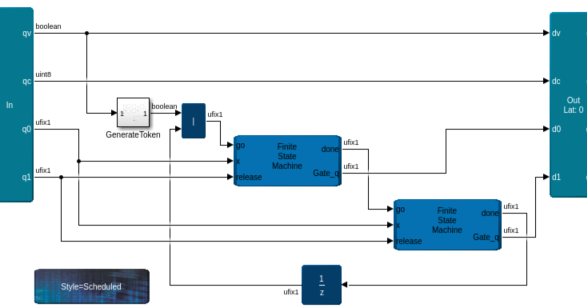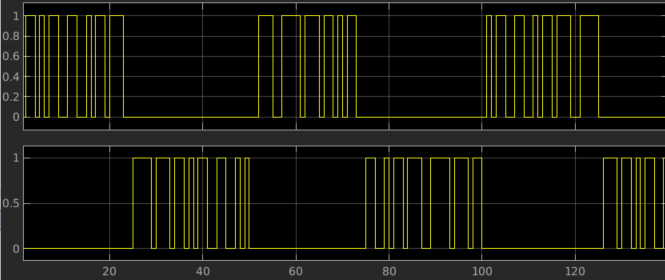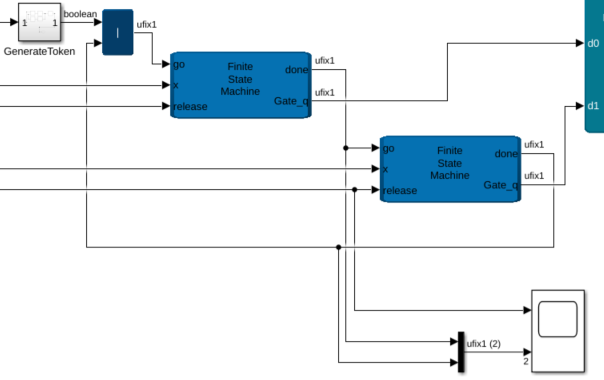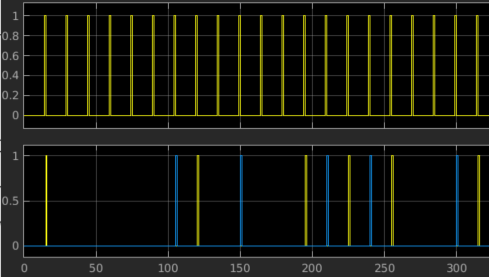DSP Builder for Intel® FPGAs (Advanced Blockset): Handbook
ID
683337
Date
7/15/2024
Public
A newer version of this document is available. Customers should click here to go to the newest version.
Answers to Top FAQs
1. About DSP Builder for Intel® FPGAs
2. DSP Builder for Intel FPGAs Advanced Blockset Getting Started
3. DSP Builder Design Flow
4. Primitive Library Blocks Tutorial
5. IP Tutorial
6. DSP Builder for Intel FPGAs (Advanced Blockset) Design Examples and Reference Designs
7. DSP Builder Design Rules, Design Recommendations, and Troubleshooting
8. About DSP Builder for Intel FPGAs Optimization
9. About Folding
10. Floating-Point Data Types
11. Design Configuration Library
12. IP Library
13. Interfaces Library
14. Primitives Library
15. Utilities Library
16. Simulink Supported Blocks
17. Document Revision History for DSP Builder for Intel FPGAs (Advanced Blockset) Handbook
1.1. DSP Builder for Intel® FPGAs Features
1.2. DSP Builder for Intel® FPGAs Design Structure
1.3. DSP Builder for Intel® FPGAs Libraries
1.4. DSP Builder for Intel® FPGAs Device Support
1.5. FPGA Architecture Features for DSP Designs
1.6. DSP Design Flow in FPGAs
1.7. Software and Hardware DSP Design Flows in FPGAs
2.1. System Requirements
2.2. Installing DSP Builder for Intel® FPGAs
2.3. Licensing DSP Builder for Intel® FPGAs
2.4. Starting DSP Builder in MATLAB on Windows
2.5. Starting DSP Builder in MATLAB on Linux
2.6. Browsing DSP Builder Libraries and Adding Blocks to a New Model
2.7. Browsing and Opening DSP Builder Design Examples
2.8. Creating a New DSP Builder Design with the DSP Builder New Model Wizard
2.9. Simulating, Verifying, Generating, and Compiling Your DSP Builder Design
3.1. Implementing your Design in DSP Builder Advanced Blockset
3.2. Verifying your DSP Builder Advanced Blockset Design in Simulink and MATLAB
3.3. Exploring DSP Builder Advanced Blockset Design Tradeoffs
3.4. Verifying your DSP Builder Design with C++ Software Models
3.5. Verifying your DSP Builder Advanced Blockset Design in the ModelSim Simulator
3.6. Verifying Your DSP Builder Design in Hardware
3.7. Integrating Your DSP Builder Advanced Blockset Design into Hardware
3.1.2.1. DSP Builder Block Interface Signals
3.1.2.2. Periods
3.1.2.3. Sample Rate
3.1.2.4. Building Multichannel Systems
3.1.2.5. Channelization for Two Channels with a Folding Factor of 3
3.1.2.6. Channelization for Four Channels with a Folding Factor of 3
3.1.2.7. Synchronization and Scheduling of Data with the Channel Signal
3.1.2.8. Simulink vs Hardware Design Representations
3.2.1. Verifying your DSP Builder Advanced Blockset Design with a Testbench
3.2.2. Running DSP Builder Advanced Blockset Automatic Testbenches
3.2.3. Using DSP Builder Advanced Blockset References
3.2.4. Setting Up Stimulus in DSP Builder Advanced Blockset
3.2.5. Analyzing your DSP Builder Advanced Blockset Design
4.1. Creating a Fibonacci Design from the DSP Builder Primitive Library
4.2. Setting the Parameters on the Testbench Source Blocks
4.3. Simulating the Fibonacci Design in Simulink
4.4. Modifying the DSP Builder Fibonacci Design to Generate Vector Signals
4.5. Simulating the RTL of the Fibonacci Design
5.1. Creating an IP Design
5.2. Simulating the IP Design in Simulink
5.3. Viewing Timing Closure and Viewing Resource Utilization for the DSP Builder IP Design
5.4. Reparameterizing the DSP Builder FIR Filter to Double the Number of Channels
5.5. Doubling the Target Clock Rate for a DSP Builder IP Design
6.1. DSP Builder Design Configuration Block Design Examples
6.2. DSP Builder FFT Design Examples
6.3. DSP Builder DDC Design Example
6.4. DSP Builder Filter Design Examples
6.5. DSP Builder Finite State Machine Design Example
6.6. DSP Builder Folding Design Examples
6.7. DSP Builder Floating Point Design Examples
6.8. DSP Builder Flow Control Design Examples
6.9. DSP Builder HDL Import Design Example
6.10. DSP Builder Host Interface Design Examples
6.11. DSP Builder Fixed-Point Matrix Multiply Engine Design Example
6.12. DSP Builder Platform Design Examples
6.13. DSP Builder Primitive Block Design Examples
6.14. DSP Builder Reference Designs
6.15. DSP Builder Waveform Synthesis Design Examples
6.2.1. FFT
6.2.2. FFT without BitReverseCoreC Block
6.2.3. IFFT
6.2.4. IFFT without BitReverseCoreC Block
6.2.5. Floating-Point FFT
6.2.6. Floating-Point FFT without BitReverseCoreC Block
6.2.7. Floating-Point iFFT
6.2.8. Floating-Point iFFT without BitReverseCoreC Block
6.2.9. Multichannel FFT
6.2.10. Multiwire Transpose
6.2.11. Parallel FFT
6.2.12. Parallel Floating-Point FFT
6.2.13. Single-Wire Transpose
6.2.14. Switchable FFT/iFFT
6.2.15. Variable-Size Fixed-Point FFT
6.2.16. Variable-Size Fixed-Point FFT without BitReverseCoreC Block
6.2.17. Variable-Size Fixed-Point iFFT
6.2.18. Variable-Size Fixed-Point iFFT without BitReverseCoreC Block
6.2.19. Variable-Size Floating-Point FFT
6.2.20. Variable-Size Floating-Point FFT without BitReverseCoreC Block
6.2.21. Variable-Size Floating-Point iFFT
6.2.22. Variable-Size Floating-Point iFFT without BitReverseCoreC Block
6.2.23. Variable-Size Low-Resource FFT
6.2.24. Variable-Size Low-Resource Real-Time FFT
6.2.25. Variable-Size Supersampled FFT
6.2.26. Variable-Size Supersampled FFT with Bit-Reverse
6.4.1. Complex FIR Filter
6.4.2. Decimating CIC Filter
6.4.3. Decimating FIR Filter
6.4.4. Filter Chain with Forward Flow Control
6.4.5. FIR Filter with Exposed Bus
6.4.6. Fractional FIR Filter Chain
6.4.7. Fractional-Rate FIR Filter
6.4.8. Half-Band FIR Filter
6.4.9. IIR: Full-rate Fixed-point
6.4.10. IIR: Full-rate Floating-point
6.4.11. Interpolating CIC Filter
6.4.12. Interpolating FIR Filter
6.4.13. Interpolating FIR Filter with Multiple Coefficient Banks
6.4.14. Interpolating FIR Filter with Updating Coefficient Banks
6.4.15. Root-Raised Cosine FIR Filter
6.4.16. Single-Rate FIR Filter
6.4.17. Super-Sample Decimating FIR Filter
6.4.18. Super-Sample Fractional FIR Filter
6.4.19. Super-Sample Interpolating FIR Filter
6.4.20. Variable-Rate CIC Filter
6.7.1. Black-Scholes Floating Point
6.7.2. Double-Precision Real Floating-Point Matrix Multiply
6.7.3. Fine Doppler Estimator
6.7.4. Floating-Point Mandlebrot Set
6.7.5. General Real Matrix Multiply One Cycle Per Output
6.7.6. Newton Root Finding Tutorial Step 1—Iteration
6.7.7. Newton Root Finding Tutorial Step 2—Convergence
6.7.8. Newton Root Finding Tutorial Step 3—Valid
6.7.9. Newton Root Finding Tutorial Step 4—Control
6.7.10. Newton Root Finding Tutorial Step 5—Final
6.7.11. Normalizer
6.7.12. Single-Precision Complex Floating-Point Matrix Multiply
6.7.13. Single-Precision Real Floating-Point Matrix Multiply
6.7.14. Simple Nonadaptive 2D Beamformer
6.8.1. Avalon-ST Interface (Input and Output FIFO Buffer) with Backpressure
6.8.2. Avalon-ST Interface (Output FIFO Buffer) with Backpressure
6.8.3. Kronecker Tensor Product
6.8.4. Parallel Loops
6.8.5. Primitive FIR with Back Pressure
6.8.6. Primitive FIR with Forward Pressure
6.8.7. Primitive Systolic FIR with Forward Flow Control
6.8.8. Rectangular Nested Loop
6.8.9. Sequential Loops
6.8.10. Triangular Nested Loop
6.13.1. 8×8 Inverse Discrete Cosine Transform
6.13.2. Automatic Gain Control
6.13.3. Bit Combine for Boolean Vectors
6.13.4. Bit Extract for Boolean Vectors
6.13.5. Color Space Converter
6.13.6. CORDIC from Primitive Blocks
6.13.7. Digital Predistortion Forward Path
6.13.8. Fibonacci Series
6.13.9. Folded Vector Sort
6.13.10. Fractional Square Root Using CORDIC
6.13.11. Fixed-point Maths Functions
6.13.12. Gaussian Random Number Generator
6.13.13. Hello World
6.13.14. Hybrid Direct Form and Transpose Form FIR Filter
6.13.15. Loadable Counter
6.13.16. Matrix Initialization of LUT
6.13.17. Matrix Initialization of Vector Memories
6.13.18. Multichannel IIR Filter
6.13.19. Quadrature Amplitude Modulation
6.13.20. Reinterpret Cast for Bit Packing and Unpacking
6.13.21. Run-time Configurable Decimating and Interpolating Half-Rate FIR Filter
6.13.22. Square Root Using CORDIC
6.13.23. Test CORDIC Functions with the CORDIC Block
6.13.24. Uniform Random Number Generator
6.13.25. Vector Sort—Sequential
6.13.26. Vector Sort—Iterative
6.13.27. Vector Initialization of Sample Delay
6.13.28. Wide Single-Channel Accumulators
6.14.1. 1-Antenna WiMAX DDC
6.14.2. 2-Antenna WiMAX DDC
6.14.3. 1-Antenna WiMAX DUC
6.14.4. 2-Antenna WiMAX DUC
6.14.5. 4-Carrier, 2-Antenna W-CDMA DDC
6.14.6. 1-Carrier, 2-Antenna W-CDMA DDC
6.14.7. 4-Carrier, 2-Antenna W-CDMA DUC
6.14.8. 4-Carrier, 4-Antenna DUC and DDC for LTE
6.14.9. 1-Carrier, 2-Antenna W-CDMA DDC
6.14.10. 4-Carrier, 2-Antenna High-Speed W-CDMA DUC at 368.64 MHz with Total Rate Change 32
6.14.11. 4-Carrier, 2-Antenna High-Speed W-CDMA DUC at 368.64 MHz with Total Rate Change 48
6.14.12. 4-Carrier, 2-Antenna High-Speed W-CDMA DUC at 307.2 MHz with Total Rate Change 40
6.14.13. Cholesky-based Matrix Inversion
6.14.14. Cholesky Solver Multiple Channels
6.14.15. Crest Factor Reduction
6.14.16. Direct RF with Synthesizable Testbench
6.14.17. Dynamic Decimating FIR Filter
6.14.18. Multichannel QR Decompostion
6.14.19. QR Decompostion
6.14.20. QRD Solver
6.14.21. Reconfigurable Decimation Filter
6.14.22. Single-Channel 10-MHz LTE Transmitter
6.14.23. STAP Radar Forward and Backward Substitution
6.14.24. STAP Radar Steering Generation
6.14.25. STAP Radar QR Decomposition 192x204
6.14.26. Time Delay Beamformer
6.14.27. Transmit and Receive Modem
6.14.28. Variable Integer Rate Decimation Filter
8.1. Associating DSP Builder with MATLAB
8.2. Setting Up Simulink for DSP Builder Designs
8.3. The DSP Builder Windows Shortcut
8.4. Setting DSP Builder Design Parameters with MATLAB Scripts
8.5. Managing your Designs
8.6. How to Manage Latency
8.7. Flow Control in DSP Builder Designs
8.8. Reset Minimization
8.9. About Importing HDL
10.1. DSP Builder Floating-Point Data Type Features
10.2. DSP Builder Supported Floating-Point Data Types
10.3. DSP Builder Round-Off Errors
10.4. Trading Off Logic Utilization and Accuracy in DSP Builder Designs
10.5. Upgrading Pre v14.0 Designs
10.6. Floating-Point Sine Wave Generator Tutorial
10.7. Newton-Raphson Root Finding Tutorial
10.8. Forcing Soft Floating-point Data Types with the Advanced Options
12.1.1. DSP Builder FIR and CIC Filters
12.1.2. DSP Builder FIR Filters
12.1.3. Channel Viewer (ChanView)
12.1.4. Complex Mixer (ComplexMixer)
12.1.5. Decimating CIC
12.1.6. Decimating FIR
12.1.7. Fractional Rate FIR
12.1.8. Interpolating CIC
12.1.9. Interpolating FIR
12.1.10. NCO
12.1.11. Real Mixer (Mixer)
12.1.12. Scale
12.1.13. Single-Rate FIR
13.1.1. Bus Slave (BusSlave)
13.1.2. Bus Stimulus (BusStimulus)
13.1.3. Bus Stimulus File Reader (Bus StimulusFileReader)
13.1.4. External Memory, Memory Read, Memory Write
13.1.5. Register Bit (RegBit)
13.1.6. Register Field (RegField)
13.1.7. Register Out (RegOut)
13.1.8. Shared Memory (SharedMem)
14.3.1. About Pruning and Twiddle for FFT Blocks
14.3.2. Bit Vector Combine (BitVectorCombine)
14.3.3. Butterfly Unit (BFU)
14.3.4. Butterfly I C (BFIC) (Deprecated)
14.3.5. Butterfly II C (BFIIC) (Deprecated)
14.3.6. Choose Bits (ChooseBits)
14.3.7. Crossover Switch (XSwitch)
14.3.8. Dual Twiddle Memory (DualTwiddleMemoryC)
14.3.9. Edge Detect (EdgeDetect)
14.3.10. Floating-Point Twiddle Generator (TwiddleGenF) (Deprecated)
14.3.11. Fully-Parallel FFTs (FFT2P, FFT4P, FFT8P, FFT16P, FFT32P, and FFT64P)
14.3.12. Fully-Parallel FFTs with Flexible Ordering (FFT2X, FFT4X, FFT8X, FFT16X, FFT32X, and FFT64X)
14.3.13. General Multitwiddle and General Twiddle (GeneralMultiTwiddle, GeneralMultVTwiddle, GeneralTwiddle, GeneralVTwiddle)
14.3.14. Hybrid FFT (Hybrid_FFT, HybridVFFT, HybridVFFT_btb)
14.3.15. Multiwire Transpose (MultiwireTranspose)
14.3.16. Multiwire Variable Bit Reverse (MultiwireVariableBitReverse)
14.3.17. Parallel Pipelined FFT (PFFT_Pipe)
14.3.18. Pulse Divider (PulseDivider)
14.3.19. Pulse Multiplier (PulseMultiplier)
14.3.20. Single-Wire Transpose (Transpose)
14.3.21. Split Scalar (SplitScalar)
14.3.22. Streaming FFTs (FFT2, FFT4, VFFT2, and VFFT4)
14.3.23. Stretch Pulse (StretchPulse)
14.3.24. Twiddle Angle (TwiddleAngle)
14.3.25. Twiddle Generator (TwiddleGenC) Deprecated
14.3.26. Twiddle and Variable Twiddle (Twiddle and VTwiddle)
14.3.27. Twiddle ROM (TwiddleRom, TwiddleMultRom and TwiddleRomF (deprecated))
14.4.1. Absolute Value (Abs)
14.4.2. Accumulator (Acc)
14.4.3. Add
14.4.4. Add SLoad (AddSLoad)
14.4.5. AddSub
14.4.6. AddSubFused
14.4.7. AND Gate (And)
14.4.8. Bit Combine (BitCombine)
14.4.9. Bit Extract (BitExtract)
14.4.10. Bit Reverse (BitReverse)
14.4.11. Compare (CmpCtrl)
14.4.12. Complex Conjugate (ComplexConjugate)
14.4.13. Compare Equality (CmpEQ)
14.4.14. Compare Greater Than (CmpGE)
14.4.15. Compare Less Than (CmpLT)
14.4.16. Compare Not Equal (CmpNE)
14.4.17. Constant (Const)
14.4.18. Constant Multiply (Const Mult)
14.4.19. Convert
14.4.20. CORDIC
14.4.21. Counter
14.4.22. Count Leading Zeros, Ones, or Sign Bits (CLZ)
14.4.23. Dual Memory (DualMem)
14.4.24. Demultiplexer (Demux)
14.4.25. Divide
14.4.26. Fanout
14.4.27. FIFO
14.4.28. Floating-point Classifier (FloatClass)
14.4.29. Floating-point Multiply Accumulate (MultAcc)
14.4.30. ForLoop
14.4.31. Load Exponent (LdExp)
14.4.32. Left Shift (LShift)
14.4.33. Loadable Counter (LoadableCounter)
14.4.34. Look-Up Table (Lut)
14.4.35. Loop
14.4.36. Math
14.4.37. Minimum and Maximum (MinMax)
14.4.38. MinMaxCtrl
14.4.39. Multiply (Mult)
14.4.40. Multiplexer (Mux)
14.4.41. NAND Gate (Nand)
14.4.42. Negate
14.4.43. NOR Gate (Nor)
14.4.44. NOT Gate (Not)
14.4.45. OR Gate (Or)
14.4.46. Polynomial
14.4.47. Ready
14.4.48. Reinterpret Cast (ReinterpretCast)
14.4.49. Round
14.4.50. Sample Delay (SampleDelay)
14.4.51. Scalar Product
14.4.52. Select
14.4.53. Sequence
14.4.54. Shift
14.4.55. Sqrt
14.4.56. Subtract (Sub)
14.4.57. Sum of Elements (SumOfElements)
14.4.58. Trig
14.4.59. XNOR Gate (Xnor)
14.4.60. XOR Gate (Xor)
14.6.1. Anchored Delay
14.6.2. Complex to Real-Imag
14.6.3. Enabled Delay Line
14.6.4. Enabled Feedback Delay
14.6.5. Expand Scalar (ExpandScalar)
14.6.6. Finite State Machine
14.6.7. Nested Loops (NestedLoop1, NestedLoop2, NestedLoop3)
14.6.8. Pause
14.6.9. Reset-Priority Latch (SRlatch_PS)
14.6.10. Same Data Type (SameDT)
14.6.11. Set-Priority Latch (SRlatch)
14.6.12. Single-Cycle Latency Latch (latch_1L)
14.6.13. Tapped Line Delay (TappedLineDelay)
14.6.14. Variable Super-Sample Delay (VariableDelay)
14.6.15. Vector Fanout (VectorFanout)
14.6.16. Vector Multiplexer (VectorMux)
14.6.17. Zero-Latency Latch (latch_0L)
14.6.6.1. Adding a Finite State Machine Block to your DSP Builder Design
14.6.6.2. Modifying the Finite State Machine Block Specification File
14.6.6.3. Implement Token Passing with the Finite State Machine
14.6.6.4. Implementing a One Shot Counter with the Finite State Machine
14.6.6.5. Specifying ForLoop Control Units
14.6.6.6. Creating the Finite State Machine Configuration File
14.6.6.7. Upgrading Finite State Machine Blocks from v23.2 and Earlier
14.6.6.3. Implement Token Passing with the Finite State Machine
The first state has extra behaviors associated with it. This Finite State Machine block remains in this state if DSP Builder holds the go input at logic low (0). If you add a finish port to Finite State Machine block, the output goes logic high (1) whenever the Finite State Machine returns to the first state.
Procedure
- Specify a Finite State Machine block with token passing behaviors:
# Acts as an open gate only when the token is being held # When the release input goes high, the token is released and the gate closes require version 23.3 inputs x release finish done netlist transitions Gate : q state Stopped default Pass 0 state Pass if (release & ~x) Stopped 0 if (release & x) Stopped 1 if (~x) Pass 0 if (x) Pass 1 endThe finish keyword specifies the name for an output port on the Finite State Machine block from which DSP Builder produces any released token. This port outputs logic high (1) for one cycle whenever the Finite State Machine block completes and re-enters the start state. - Connect multiple Finite State Machine blocks:
Figure 139. Connecting Two Finite State Machine Blocks
 Figure 140. Gate_q Outputs From the two Finite State Machine blocks as the token passes between them
Figure 140. Gate_q Outputs From the two Finite State Machine blocks as the token passes between them
- Observe the SampleDelay block in the feedback path. Simulink simulates the Finite State Machine block like a direct feed-through combinational logic block. It complains of an algebraic loop if you omit the feedback SampleDelay.
The Finite State Machine block implements a Mealy machine by default when generating the state transition control logic.
- Modify this behavior by adding the moore keyword so DSP Builder implements a Moore Machine.
require version 23.3 inputs x release finish done netlist transitions Gate : q moore state Stopped default Pass 0 state Pass if (release & ~x) Stopped 0 if (release & x) Stopped 1 if (~x) Pass 0 if (x) Pass 1 endFigure 141. Moore Machine Figure 142. Moore Machine SimulationWhen the release input goes high the Finite State Machine does not always release the token as before. The Moore machine implementation now has two stopped states. One that outputs 0 and another that outputs 1. The initial state is output 0.
Figure 142. Moore Machine SimulationWhen the release input goes high the Finite State Machine does not always release the token as before. The Moore machine implementation now has two stopped states. One that outputs 0 and another that outputs 1. The initial state is output 0.
- To release the token, return to the stopped state to produce zero on all output ports:
require version 23.3 inputs x release finish done netlist transitions Gate : q moore state Stopped default Pass 0 state Pass if (release) Stopped 0 if (~x) Pass 0 if (x) Pass 1 endAlthough this code corrects the token release problem, it costs extra dead cycles where neither Finite State Machine block is active while the token is passing through output registers.